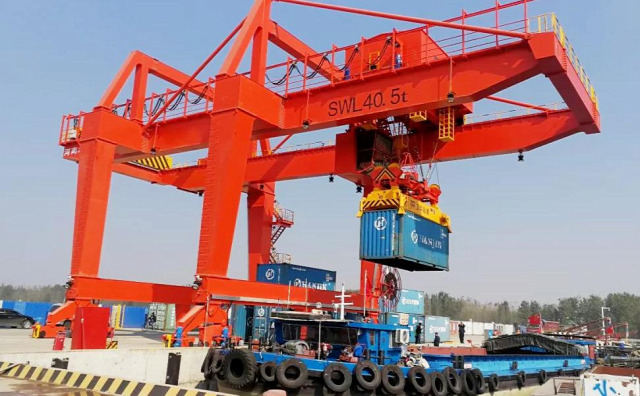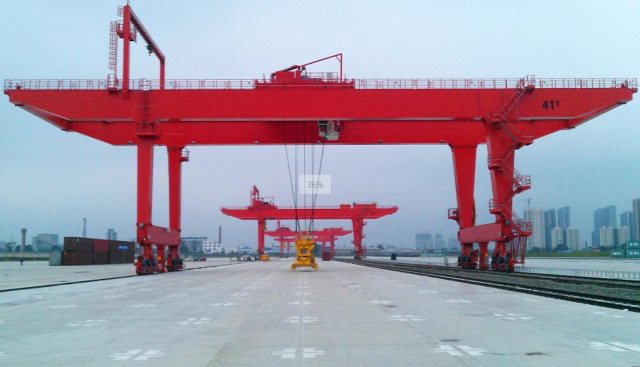Container gantry cranes are essential equipment in modern ports and terminals, designed specifically for the loading, unloading, and handling of shipping containers. With global trade heavily reliant on containerized shipping, the role of container gantry cranes in ensuring efficient, safe, and timely movement of goods has become increasingly critical. This article provides an in-depth introduction to container gantry cranes, exploring various container crane types, key uses, and the factors that make them indispensable in today’s interconnected world.

What Are Container Gantry Cranes?
Container gantry cranes are large industrial cranes built to handle and transfer containers between different modes of transport, including ships, trucks, and railcars. Typically located in seaports and container terminals, these cranes are essential for lifting and moving containers over substantial distances, facilitating smooth and efficient transport. They are generally divided into two primary types based on their mobility: Rail-Mounted Gantry (RMG) cranes and Rubber-Tired Gantry (RTG) cranes.
These cranes are highly specialized, built with massive structures and lifting capacities, allowing them to efficiently move containers that often weigh tens of tons. Their towering frames, long spans, and advanced control systems enable container gantry cranes to operate in diverse environments, from large-scale seaports to compact intermodal yards.
Types of Container Gantry Cranes
1. Rail-Mounted Gantry (RMG) Cranes
Rail-mounted gantry cranes are fixed cranes that travel along rails installed on the ground. They are primarily used in container terminals and intermodal facilities where a defined path is needed to move containers between vessels, storage yards, and railcars.
Key Characteristics of RMG Cranes:
- Fixed Path: RMG cranes move along pre-installed rail tracks, limiting their mobility but ensuring precise movements.
- High Stability and Lifting Capacity: These cranes are known for their stability, allowing them to handle very heavy loads.
- Efficient Use of Space: With a clear, designated track, RMG cranes utilize terminal space effectively, making them suitable for densely packed container yards.
- Automated Capabilities: Many modern rail mounted gantry cranes are equipped with automation features, enhancing operational efficiency and reducing labor costs.
Applications of RMG Cranes:
- Port Operations: For loading and unloading containers between ships and the storage yard.
- Rail Terminals: Ideal for transferring containers from storage areas to railcars and vice versa.

2. Rubber-Tired Gantry (RTG) Cranes
Rubber-tired gantry cranes, as the name suggests, are mobile cranes mounted on rubber tires, allowing them to move freely within the terminal. RTG cranes are popular due to their versatility and ability to operate in different areas of a terminal without being restricted to a fixed path.
Key Characteristics of RTG Cranes:
- Mobility: RTG cranes are not restricted by rails, giving them the flexibility to operate across different sections of the yard.
- Space Flexibility: They can be quickly redeployed, making them highly adaptable for dynamic yard layouts.
- Moderate to High Lifting Capacity: RTG cranes typically handle moderate-to-heavy loads, capable of lifting single or stacked containers.
- Lower Energy Efficiency Compared to RMG Cranes: Since they use tires instead of rails, RTG cranes tend to consume more energy during operation.
Applications of RTG Cranes:
- Container Yards: RTGs are commonly used in container stacking areas, arranging containers in rows and maximizing space.
- Intermodal Facilities: They are also suitable for transferring containers between trucks, railcars, and storage areas, especially where high mobility is essential.
3. Ship-to-Shore (STS) Cranes
Although not technically a type of gantry crane, Ship-to-Shore (STS) cranes are worth mentioning. They are designed to operate along the port quay, directly loading and unloading containers from ships onto land.
Key Characteristics of STS Cranes:
- Quay-Mounted: STS cranes are typically mounted on a rail system along the quay.
- Extended Reach and High Lifting Height: These cranes have a long outreach to reach the width of large container ships.
- Heavy-Duty Lifting Capacity: Capable of lifting the heaviest container loads directly from ships.
Applications of STS Cranes:
- Port Operations: Specifically designed for efficient transfer of containers from ship to land and vice versa.
Key Uses of Container Gantry Cranes
Container gantry cranes are indispensable in several key operational areas, primarily revolving around the movement and storage of containers:
1. Loading and Unloading Ships
One of the primary uses of container gantry cranes is loading and unloading containers from ships. By enabling the quick transfer of containers from ship to shore, they significantly reduce vessel turnaround time, enhancing port productivity.
2. Transferring Containers to Storage Yards
Once containers are unloaded from ships, they need to be temporarily stored in container yards. Both RMG and RTG cranes play crucial roles here, moving containers from the quay to the designated storage areas. The organization of containers in the storage yard is critical for efficient future retrieval, which is where gantry cranes excel.
3. Intermodal Transfer (Truck and Rail Loading)
Container gantry cranes are essential for intermodal transfer, where containers are moved between different transportation modes. They facilitate the quick loading and unloading of containers onto trucks and railcars, allowing goods to continue their journey through land-based transport routes.
4. Container Stacking and Storage
RTG cranes, in particular, are ideal for container stacking, organizing containers into compact rows and maximizing yard space. The ability to stack containers efficiently ensures optimal use of terminal space, especially in high-traffic areas.
Advantages of Container Gantry Cranes
1. Efficiency in Cargo Handling
Container gantry cranes dramatically speed up the handling of containers, reducing the amount of time a vessel spends docked and enabling faster turnover for carriers. This efficiency directly impacts a port's capacity to manage large volumes of cargo.
2. Flexibility and Adaptability
With both fixed (RMG) and mobile (RTG) options, container gantry cranes offer flexible solutions for varying operational needs. Ports can adjust their crane selection and layout based on available space, traffic patterns, and operational volume.
3. Improved Safety
Modern container gantry cranes are equipped with advanced safety features, including anti-sway systems, load monitoring, and collision avoidance sensors. These safety mechanisms reduce risks during lifting operations, making container handling safer for operators and equipment.
4. Environmental Efficiency
Today’s container gantry cranes are designed with energy-efficient components, like hybrid power systems and regenerative braking, which reduce fuel consumption and emissions. This eco-friendly approach helps ports minimize their environmental footprint, aligning with global sustainability goals.
Innovations in Container Gantry Cranes
1. Automation and Remote Operation
Automation has made significant inroads into the field of container handling, with automated RMG and RTG cranes that operate with minimal human intervention. Remote-controlled gantry cranes allow operators to manage crane operations from a safe, comfortable control room, reducing risks and improving efficiency.
2. Advanced Control Systems
Control systems for container gantry cranes have evolved to include intelligent features, such as automated stacking and load optimization. With smart sensors and algorithms, cranes can autonomously arrange containers in a way that maximizes yard space while considering retrieval efficiency.
3. Data Integration and IoT
The Internet of Things (IoT) enables container gantry cranes to be integrated with broader terminal management systems. Through IoT, crane data such as operating time, load cycles, and energy usage can be monitored in real time, allowing for predictive maintenance and improved operational planning.
Conclusion
Container gantry cranes are pivotal to modern containerized logistics, providing ports and terminals with the capability to manage high volumes of cargo safely, efficiently, and sustainably. With diverse types such as RMG and RTG cranes, as well as innovative features like automation, container gantry cranes have revolutionized container handling, making them indispensable assets in global trade. As technology advances, the capabilities of these cranes will only continue to expand, supporting even greater levels of efficiency and adaptability in the world’s busiest ports and terminals.

